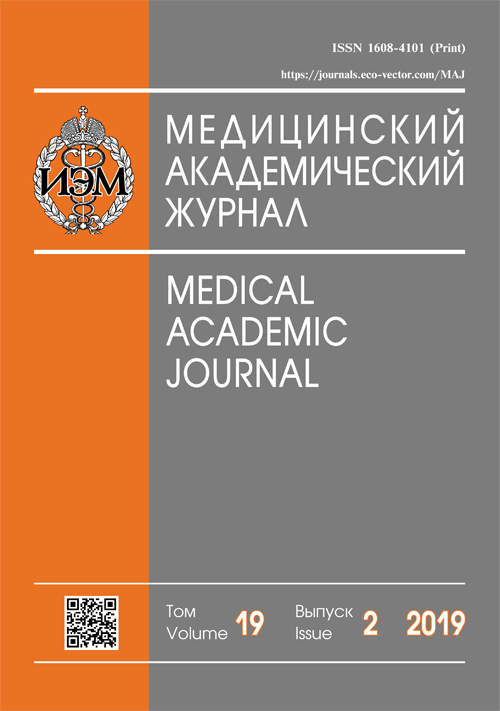Bupropion effect depends on rats’ coping style
- Authors: Zhukov D.A.1, Nemez V.V.2, Vinogradova E.P.3
-
Affiliations:
- Pavlov Institute of Physiology
- Almazov National Medical Research Center
- Saint Petersburg State University
- Issue: Vol 19, No 2 (2019)
- Pages: 53-56
- Section: Original research
- Published: 18.09.2019
- URL: https://journals.eco-vector.com/MAJ/article/view/16136
- DOI: https://doi.org/10.17816/MAJ19253-56
- ID: 16136
Cite item
Abstract
Objective. The effect of antidepressant bupropion on the behavior of rats subjected to chronic mild unpredictable stress was investigated. Rats with opposite coping styles — active and passive — were subjected to stress.
Materials and methods. In the population of outbred animals Wistar were isolated individuals with the opposite coping styles on the basis of the acquisition of active avoidance. The animals of these two groups were tested in the Porsolt’s test and in the elevated plus-maze, and then subjected to chronic stress.
Results. Behavioral deficits were more pronounced in rats with initial active coping style. After administration of bupropion behavior in the Porsolt’s test was restored only in rats with initially active coping style. On the behavior of animals with an initially passive coping style, bupropion had no impact.
Conclusion. Our findings suggest the different nature of post-stress disorders in animals with different active and passive coping styles.
Keywords
Full Text
About the authors
Dmitry A. Zhukov
Pavlov Institute of Physiology
Author for correspondence.
Email: dazhukov0@gmail.com
ResearcherId: J-8616-2018
PhD, DrSci, senior scientist of the Department of Comparative Behavioral Genetics
Russian Federation, Saint PetersburgVsevolod V. Nemez
Almazov National Medical Research Center
Email: seva_nemets@list.ru
SPIN-code: 4081-8098
Scientist
Russian Federation, Saint PetersburgEkaterina P. Vinogradova
Saint Petersburg State University
Email: katvinog@yahoo.com
ORCID iD: 0000-0003-2275-4084
SPIN-code: 4899-1537
ResearcherId: F-6877-2015
PhD, Associative Professor of the Department of Higher Nervous Activity and Psychophysiology
Russian Federation, Saint PetersburgReferences
- Drugan RC, Basile AS, Ha JH, et al. Analysis of the importance of controllable versus uncontrollable stress on subsequent behavioral and physiological functioning. Brain Res Brain Res Protoc. 1997;2(1):69-74.
- Willner P. The chronic mild stress (CMS) model of depression: history, evaluation and usage. Neurobiol Stress. 2016;6:78-93. https://doi.org/10.1016/j.ynstr.2016.08.002.
- Виноградова Е.П., Немец В.В., Жуков Д.А. Активная стратегия поведения как фактор риска депрессивноподобных нарушений после хронического умеренного стресса // Журнал высшей нервной деятельности им. И.П. Павлова. – 2013. – Т. 63. – № 5. – С. 589–596. [Vinogradova EP, Nemets VV, Zhukov DA. Active coping style as a risk factor of depressive-like disorder after chronic mild stress. Zh Vyssh Nerv Deiat Pavlov. 2013;63(5):589-596. (In Russ.)]. https://doi.org/10.7868/S0044467713050109.
- WorldLII. European convention for the protection of vertebrate animals used for experimentation and other scientific purposes – Explanatory Report – 1986. COETSER 1 [cite 1986 March 18]. Available from: http://www.worldlii.org/int/other/COETSER/1986/1.html.
- Melis MR, Sanna F, Argiolas A. Rats selectively bred for showing divergent behavioral traits in response to stress or novelty or spontaneous yawning with a divergent frequency show similar changes in sexual behavior: the role of dopamine. Rev Neurosci. 2019;30(4):427-454. https://doi.org/10.1515/revneuro-2018-0058.
- Виноградова Е.П., Жуков Д.А. Выработка пассивного избегания у крыс линий КНА и KLA // Физиологический журнал им. И.М. Сеченова. – 1998. – Т. 84. – № 1-2. – C. 131–132. [Vinogradova EP, Zhukov DA. Acquisition of passive avoidance in KHA and KLA rat strains. Fiziol Zhur. im I.M. Sechenov. 1998;84(1-2):131-132. (In Russ.)]
- Lane SM, Briffa M. Boldness is for rookies: prefight boldness and fighting success in a sea anemone. Animal Behav. 2017;132(10):13-20. https://doi.org/10.1016/j.anbehav.2017.07.012.
- Friedman M, Rosenman R. Association of specific overt behaviour pattern with blood and cardiovascular findings; blood cholesterol level, blood clotting time, incidence of arcus senilis, and clinical coronary artery disease. J Am Med Assoc. 1959;169(12):1286-1296. https://doi.org/10.1001/jama.1959.03000290012005.
- Жуков Д.А. Реакция особи на неконтролируемое воздействие зависит от стратегии поведения // Российский физиологический журнал им. И.М. Сеченова. – 1996. – Т. 82. – № 4. – С. 21–29. [Zhukov DA. Reaktsiya osobi na nekontroliruemoe vozdejstvie zavisit ot strategii povedeniya. Ross Fiziol Zh Im I M Sechenova. 1996;82(4):21-29. (In Russ.)]
- Carrasco MC, Vicens P, Vidal J, Redolat R. Effects of acute administration of bupropion on behavior in the elevated plus-maze test by NMRI mice. Prog Neuropsychopharmacol Biol Psychiatry. 2004;28(7):1135-1141. https://doi.org/10.1016/j.pnpbp.2004.06.005.
- Muscat R, Papp M, Willner P. Antidepressant-like effects of dopamine agonists in an animal model of depression. Biol Psychiatry. 1992;31(9):937-946. https://doi.org/10.1016/0006-3223(92)90119-k.
- Santamaría A, Arias HR. Neurochemical and behavioral effects elicited by bupropion and diethylpropion in rats. Behav Brain Res. 2010;211(1):132-139. https://doi.org/10.1016/j.bbr.2010.03.023.
- Вишневецкая Г.Б., Августинович Д.Ф., Кудрявцева Н.Н. Устойчивость мышей линии DBA/2J к действию стресса постоянных социальных поражений // Журнал высшей нервной деятельности им. И.П. Павлова. – 2016. – Т. 66. – № 3. – С. 338–351. [Vishnivetskaya GB, Avgustinovich DF, Kudryavtseva NN. Resistance of DBA/2J mice to the chronic social defeat stress. Zh Vyssh Nerv Deiat Pavlov. 2016;66(3):338-351. (In Russ.)]. https://doi.org/10.7868/S0044467716030138.
Supplementary files







